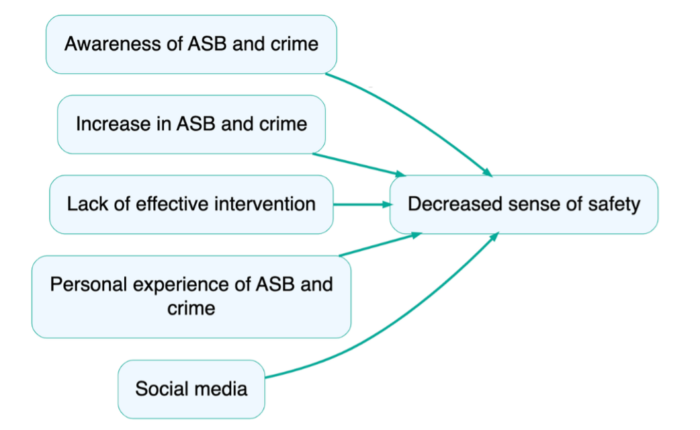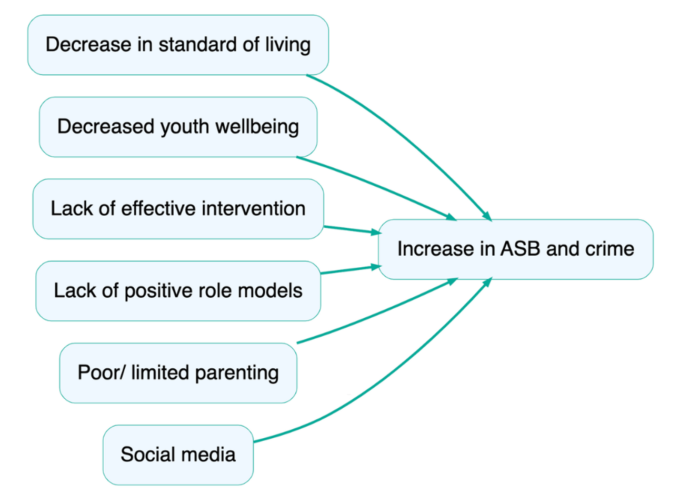Thank you for participating in the Safer Streets Fund evaluation research!
This page provides an overview of the research you contributed to. We will add an overview of our findings once the study is complete later in 2024.
Who is using this research?
We are an independent research organisation contracted to deliver one part of a larger evaluation by Verian (formerly Kantar Public) on behalf of the Home Office. The evaluation focuses on the UK Government’s Safer Streets Fund round 4 (SSF4) which aims to reduce neighbourhood crime, anti-social behaviour (ASB) and violence against women and girls, as well as improve perceptions of safety in local areas. The research aims to understand what impact the SSF4 interventions have had, and where the fund has had most impact so that future interventions can build on success and learn from failure. Bath SDR has no material interest in the results and we remain impartial in the execution of this research which we intend will provide a faithful account of what you, as key stakeholders, told us about your experiences.
Where did interviews take place?
- Swindon
- Gwent
These were chosen due to the range and high number of SSF4 interventions going on in these areas.
Who took part?
We asked the following groups to participate:
- Parents whose children took part in activities funded by SSF4
- Youth workers who have been connected with SSF4 interventions
- Teachers working in the areas in which SSF4 interventions are present
- Local people living in the areas in which SSF4 interventions are present
We found it hard to engage parents to participate in this research, so more respondents were instead selected from the other three groups.
These groups were invited to take part in an interview to understand more about their perceptions of the levels of and types of anti-social behaviour they are aware of in their community, and whether they felt that anything had changed over the past year.
This QuIP study made up one part of a bigger evaluation for the Home Office. Verian also conducted a survey and interviewed key informants such as those who work in the night-time economy and members of the general public.
Findings

A total of 37/68 of you discussed a SSF4-funded intervention during your interview; most mentions were from youth workers and teachers. The most frequently reported outcomes of SSF4-funded activities are shown in the figure below:

Improved youth wellbeing was the most mentioned positive outcome and included:
- Better mental and physical health
- Increased knowledge and skills
- Increased self-confidence, self-worth, and respect
Improved youth relationships included relationships with peers and members of the public. Some youth workers, particularly those from Gwent, also reported that SSF4-funded programmes increased community cohesion.
Environmental interventions such as improved street lighting and CCTV were also reported to contribute to an increased feeling of safety. These findings are consistent with SSF4’s theory of change; increasing safety through improved technological surveillance and more timely support for at-risk individuals.
More details on interventions
You told us that one-on-one mentoring programmes as well as relationship and safety-focused educational workshops were linked to positive outcomes such as development of skills and knowledge.
‘I see lots of mentoring services, the safer streets programme, the programme addressing violence against women and girls, boxing interventions. I see these making a difference every day.’
Swindon youth worker
The youth-led nature of some SSF4 outreach and support interventions was noted as beneficial by youth workers, particularly in Gwent. Young people were given choice over how and where they engaged with mentors and encouraged to take on leadership opportunities. Youth workers reported that by being given positions of responsibility the young leader gained self-confidence and reduced their ASB. This also provided positive peer role models for other young people.
‘One young person was getting in a lot of trouble, well on his way to being permanently excluded from school. Now he runs the inflatable football and is really good with the young ones and they look up to him. The youth leaders are benefitting as are the younger children.’
Swindon youth worker
In Gwent, youth workers commented on the positive impact of more integrated youth provision helped by SSF4 funding resulting in improved youth relationships & wellbeing and community cohesion.
Many of you talked about interventions which were not attributed to SSF4, although SSF4 were funding similar projects elsewhere. These were often run by schools, charitable organisations, and local councils and you told us about similar outcomes; improved youth wellbeing, relationships and feelings of safety.
Limitations

You also told us about what you felt were the limitations of SSF4 initiatives. Some young people had explained they felt some of the interventions were irrelevant to them, for example when they found guest speakers unrelatable.
You expressed frustration at the short duration of some interventions which made building trust and relationships with young people difficult. The end of SSF4-funding led to the closure or reduction in opening hours of some youth clubs due to reduced staff and unmet expectations of activities by the community, which had a negative effect on young people.
Perceptions of safety

Overall, you reported feeling slightly less safe than the year before. This was associated with personal encounters of ASB or criminal incidents, along with increased exposure to and awareness of ASB and crime through media channels. The most common reasons you gave for feeling less safe are shown below:

Where you told us that you felt safer, this was mostly linked to an intervention, whether funded by SSF4 or not, or improved community cohesion.
Perceptions of anti-social behaviour and crimes

You told us that increases in ASB were mostly linked to intimidation or harassment, gang culture and fighting. Some of you also talked about environmental ASB; litter, vandalism and graffiti. The main types of crime perceived to be increasing over the last year were drug-taking/ dealing and increased instances of people carrying and using knives.

Where there were cases of anti-social behaviour getting better, these were linked to interventions.
Your recommendations

The positive impacts of what you perceived to be useful interventions were clear, and many of you expressed a desire for these to be scaled up and given longer-term funding and security to allow deeper relationships to be built with young people. These included:
- Diversionary activities and safe spaces, mainly youth centres and recreational facilities
- Social interventions, such as joined-up community services
- Education focused initiatives, such as ASB and crime awareness
- Increased police presence and engagement with the community
- Personal interventions, such as mentoring or sports/fitness
As well as increased government funding to support these interventions, youth workers and teachers talked about a need for more engagement by parents and longer-term interventions.
Next steps
These findings have been presented to the Home Office and will be incorporated into a wider evaluation impact report written by Verian for the Home Office. A version of this report will be made public in the future.
Thank you!

Get in touch with Bath SDR
If you want to tell us more, or give us feedback, please email: info@bathsdr.org
If you would like to learn more about the QuIP methodology check out this webpage.


